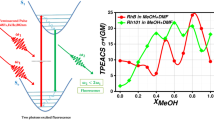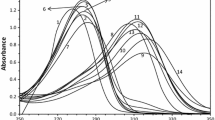Abstract
The present study elucidates the synergetic solvation behavior of t-butanol–dichloromethane (t-BuOH–DCM) binary solvent mixtures. UV–visible absorption, emission and 1H-NMR spectroscopy along with analytical modelling were used to ascertain the nature of interactions present, which are found to be maximum at X t-BuOH = 0.40, leading to a super solvation environment. The increased polarity of the t-BuOH–DCM binary solvent mixtures through interactive solvent association is believed provide a unique reaction medium that can alter the fate of chemical processes involving a polar species. This idea has been demonstrated by the transformation of merocyanine to 1′,3′-dihydro-,1′,3′,3′-trimethyl-6-nitropiro[2H-1-benzopyran-2,2′-(2H)-indole] and the oxidation of cholestanol to cholestanone.








Similar content being viewed by others
References
Parker, A.J.: Protic-dipolar aprotic solvent effects on rates of bimolecular reactions. Chem. Rev. 69, 1–32 (1969)
Dernbecher, K., Gauglitz, G.: Solvent effects on the thermal reaction of photochromic dihydroindolizines: friction or polarizability effect within the alkanes. J. Chem. Phys. 97, 3245–3251 (1992)
Proutiere, F., Schoenebeck, F.: Solvent effect on palladium-catalyzed cross-coupling reactions and implications on the active catalytic species. Angew. Chem. Int. Ed. 50, 8192–8195 (2011)
Gao, F., Boyles, D., Sullivan, R., Compton, R.N., Pagni, R.M.: Photochemistry of racemic and resolved 2-iodooctane. Effect of solvent polarity and viscosity on the chemistry. J. Org. Chem. 67, 9361–9367 (2002)
Jaquith, J.B., Guan, J., Wang, S., Collins, S.: Asymmetric induction in the Diels–Alder reaction catalyzed by chiral metallocenetriflate complexes: dramatic effect of solvent polarity. Organometallics 14, 1079–1081 (1995)
Cativiela, C., Garcia, J.I., Gil, J., Martinez, R.M., Mayoral, J.A., Salvatella, L., Urieta, J.S., Mainar, A.M., Abraham, M.H.: Solvent effects on Diels–Alder reactions. The use of aqueous mixtures of fluorinated alcohols and the study of reactions of acrylonitrile. J. Chem. Soc. Perkin Trans. 2, 653–660 (1997)
Adams, D.J., Dyson, P.J., Tavener, S.J.: Chemistry in Alternative Reaction Media. Wiley, Chichester (2004)
Hart, S.A., Trindle, C.O., Etzkorn, F.A.: Solvent-dependent stereoselectivity in a Still–Wittig rearrangement: an experimental and ab initio study. Org. Lett. 3, 1789–1791 (2001)
Mei, Y., Averill, D.J., Allen, M.J.: Study of the lanthanide-catalyzed, aqueous, asymmetric Mukaiyama aldol reaction. J. Org. Chem. 77, 5624–5632 (2012)
Mori, T., Kato, S.: Grignard reagents in solution: theoretical study of the equilibria and the reaction with a carbonyl compound in diethyl ether solvent. J. Phys. Chem. A 113, 6158–6165 (2009)
Gertner, B.J., Whitnell, R.M., Wilson, K.R., Hynes, J.T.: Activation to the transition state: reactant and solvent energy flow for a model SN2 reaction in water. J. Am. Chem. Soc. 113, 74–87 (1991)
Olsson, M.H.M., Warshel, A.: Solute solvent dynamics and energetics in enzyme catalysis: the SN2 reaction of dehalogenase as a general benchmark. J. Am. Chem. Soc. 126, 15167–15179 (2004)
Yu, H.A., Karplus, M.: An integral equation theory study of the solvent-induced reaction barrier in the nucleophilic addition of hydroxide to formaldehyde. J. Am. Chem. Soc. 112, 5706–5716 (1990)
Shinde, S.S., Lee, B.S., Chi, D.Y.: Synergistic effect of two solvents, tert-alcohol and ionic liquid, in one molecule in nucleophilic fluorination. Org. Lett. 10, 733–735 (2008)
Khupse, N.D., Kumar, A.: The cosolvent-directed Diels–Alder reaction in ionic liquids. J. Phys. Chem. A 115, 10211–10217 (2011)
Kumar, A., Pawar, S.S.: Ionic liquids as powerful solvent media for improving catalytic performance of silyl borate catalyst to promote Diels–Alder reactions. J. Org. Chem. 72, 8111–8114 (2007)
Kumar, A., Pawar, S.S.: Converting exo-selective Diels–Alder reaction to endo-selective in chloroloaluminate ionic liquids. J. Org. Chem. 69, 1419–1420 (2004)
Turner, C.H., Brennan, J.K., Johnson, J.K., Gubbins, K.E.: Effect of confinement by porous materials on chemical reaction kinetics. J. Chem. Phys. 116, 2138–2148 (2002)
Halls, M.D., Schlegel, H.B.: Chemistry inside carbon nanotubes: the Menshutkin SN2 reaction. J. Phys. Chem. B 106, 1921–1925 (2002)
Yoshizawa, M., Takeyama, Y., Okano, T., Fujita, M.: Cavity-directed synthesis within a self-assembled coordination cage: highly selective [2 + 2] cross-photodimerization of olefins. J. Am. Chem. Soc. 125, 3243–3247 (2003)
Johnson, M.D., Lorenz, B.B., Wilkins, P.C., Lemons, B.G., Baruah, B., Lamborn, N., Stahla, M., Chatterjee, P.B., Richens, D.T., Crans, D.C.: Switching off electron transfer reactions in confined media: Reduction of [Co(dipic)2]—and [Co(edta)]—by hexacyanoferrate(II). Inorg. Chem. 51, 2757–2765 (2012)
Li, X.F., Zong, M.H., Zhao, G.L.: Highly regioselective enzymatic synthesis of 5′-O-stearate of 1-β-d-arabinofuranosylcytosine in binary organic solvent mixtures. Appl. Microbiol. Biotechnol. 88, 57–63 (2010)
Rispens, T., Engberts, J.B.F.N.: Kinetic solvent effects on 1,3-dipolar cycloadditions of benzonitrile oxide. J. Phys. Org. Chem. 18, 908–917 (2005)
Sieburth, S.M., McGee, K.F.: Solvent-dependent stereoselectivity of bis-2-pyridone [4 + 4] photocycloaddition is due to H-bonded dimers. Org. Lett. 1, 1775–1777 (1999)
Mancini, P.M.E., Terenzani, A., Adam, C., Vottero, L.R.: Solvent effects on aromatic nucleophilic substitution reactions. Part 9. Special kinetic synergistic behavior in binary solvent mixtures. J. Phys. Org. Chem. 12, 430–440 (1999)
Zhong, M., Nowak, I., Robins, M.J.: Regiospecific and highly stereoselective coupling of 6-(substituted-imidazol-1-yl)purines with 2-deoxy-3,5-di-O-(p-toluoyl)-α-d-erythro-pentofuranosyl chloride. Sodium-salt glycosylation in binary solvent mixtures: improved synthesis of cladribine. J. Org. Chem. 71, 7773–7779 (2006)
Siani, G., Angelini, G., Maria, P.D., Fintana, A., Pierini, M.: Solvent effects on the rate of the keto–enol interconversion of 2-nitrocyclohexanone. Org. Biomol. Chem. 6, 4236–4241 (2008)
Iglesias, E.: Solvent effects versus concentration effects in determining rates of base-catalyzed keto–enol tautomerization. New J. Chem. 29, 625–632 (2005)
Toyouchi, S., Kajimoto, S., Barzan, D., Kiel, A., Enderlein, J., Fukumura, H., Herten, D.P.: Observation of unusual molecular diffusion behaviour below the lower critical solution temperature of water/2-butoxyethanol mixtures by using fluorescence correlation spectroscopy. Chem. Phys. Chem. 15, 3832–3838 (2014)
Beniwal, V., Kumar, A.: Synergistic effects and correlating polarity parameters in binary mixtures of ionic liquids. Chem. Phys. Chem. 16, 1026–1034 (2015)
Gupta, S., Chakraborty, A., Sen, P.: Elucidation of intriguing methanol–dichloromethane binary solvent mixture: synergistic effect, analytical modeling, NMR and photo-induced electron transfer studies. J. Mol. Liq. 223, 274–282 (2016)
Gupta, S., Rafiq, S., Kundu, M., Sen, P.: Origin of strong synergism in weakly perturbed binary solvent system: a case study of primary alcohols and chlorinated methanes. J. Phys. Chem. B 116, 1345–1355 (2012)
Gupta, S., Rafiq, S., Sen, P.: Dynamics of solvent response in methanol–chloroform binary solvent mixture: a case of synergistic solvation. J. Phys. Chem. B 119, 3135–3141 (2015)
Moorthy, J.N., Senapati, K., Parida, K.N., Jhulki, S., Sooraj, K., Nair, N.N.: Twist does a twist to the reactivity: stoichiometric and catalytic oxidations with twisted tetramethyl-IBX. J. Org. Chem. 76, 9593–9601 (2011)
Felpin, F.X., Fouquet, E.: Reliable and safe, gram-scale hydrogenation and hydrogenolysis of O-benzyl ether groups with in situ Pd0/C catalyst. Synthesis 18, 2893–2896 (2011)
Marcus, Y.: Structure enhancement in water-rich binary solvent mixtures. J. Mol. Liq. 158, 23–26 (2011)
Fortunato, G.G., Mancini, P.M., Bravo, M.V., Adam, C.G.: New solvents designed on the basis of the molecular-microscopic properties of binary mixtures of the type (protic molecular solvent + 1-butyl-3-methylimidazolium-based ionic liquid). J. Phys. Chem. B 114, 11804–11819 (2010)
Petrov, NKh: A Fluorescence spectroscopy study of preferential solvation in binary solvents. High Energy Chem. 40, 22–34 (2006)
Petrov, NKh, Borisenko, V.N., Alfimov, M.V.: Study of preferential solvation in binary solvent mixtures by the fluorescence-detected magnetic field effect. J. Chem. Soc., Faraday Trans. 90, 109–111 (1994)
Suppan, P.: Chemistry and Light. Royal Society of Chemistry, Cambridge (1994)
Machado, V.G., Machado, C.: An easy and versatile experiment to demonstrate solvent polarity using solvatochromic dyes. J. Chem. Educ. 78, 649–651 (2001)
Choi, J.Y., Park, E.J., Chang, S.H., Kang, T.: Solvent effects on the solvatochromism of 7-aminocoumarin derivatives in neat and binary solvent mixtures: correlation of the electronic transition energies with the solvent polarity parameters. J. Bull. Korean Chem. Soc. 30, 1452–1458 (2009)
Roses, M., Rafols, C., Ortega, J., Bosch, E.: Solute–solvent and solvent–solvent interactions in binary solvent mixtures: Part 1. A comparison of several preferential solvation models for describing E T(30) polarity of bipolar hydrogen bond acceptor-cosolvent mixtures. J. Chem. Soc. Perkin Trans. 2, 1607–1615 (1995)
Herodes, K., Leito, L., Koppel, I., Roses, M.: Solute–solvent and solvent–solvent interactions in binary solvent mixtures: Part 8. The E T(30) polarity of binary mixtures of formamides with hydroxylic solvents. J. Phys. Org. Chem. 12, 109–115 (1999)
Boach, E., Roses, M., Herodes, K., Koppel, I., Leito, L., Koppel, I., Taal, V.: Solute–solvent and solvent–solvent interactions in binary solvent mixtures: 2. Effect of temperature on the E T(30) polarity parameter of dipolar hydrogen bond acceptor–hydrogen bond donor mixtures. J. Phys. Org. Chem. 9, 403–410 (1996)
El Secoud, O.A.: Solvation in pure and mixed solvent: some recent developments. Pure Appl. Chem. 79, 1135–1151 (2007)
Song, X., Zhou, J., Li, Y., Tang, Y.: Correlations between solvatochromism, Lewis acid–base equilibrium and photochromism of an indolinespiropyran. J. Photochem. Photobiol. A 92, 99–103 (1995)
Byrne, R., Fraser, K.J., Izgorodina, E., MacFarlane, D.R., Forsyth, M., Diamond, D.: Photo- and solvatochromic properties of nitrobenzospiropyran in ionic liquids containing the [NTf2]− anion. Phys. Chem. Chem. Phys. 10, 5919–5924 (2008)
Minkin, V.I.: Photo-, thermo-, solvato-, and electrochromic spiroheterocyclic compounds. Chem. Rev. 104, 2751–2776 (2004)
Gorner, H.: Photochromism of nitrospiropyrans: effects of structure, solvent and temperature. Phys. Chem. Chem. Phys. 3, 416–423 (2001)
Acknowledgements
SG and KNP thank CSIR (Council of Scientific and Industrial Research, India) and PM thanks UGC (University Grants Commission, India) for awarding a fellowship. We thank Professor J. N. Moorthy for his help to conduct the cholestanol oxidation study in his laboratory and for providing cholestanol and TetMe-IBX. This work is financially supported by the Science and Engineering Research Board, Department of Science and Technology, Government of India (Project No. SR/S1/PC-08/2011) and IIT Kanpur.
Author information
Authors and Affiliations
Corresponding author
Electronic supplementary material
Below is the link to the electronic supplementary material.
10953_2017_586_MOESM1_ESM.docx
Description of flash photolysis setup, plots of absorption and emission spectra of coumarin 480 in different compositions of t-BuOH–DCM binary solvent mixture, 1H-NMR of DCM proton and –OH proton of t-BuOH with varying mole fraction of t-BuOH in t-BuOH–DCM binary solvent mixture, procedure for oxidation of cholestanol to cholestanone by tetramethyl-IBX. (DOCX 585 kb)
Rights and permissions
About this article
Cite this article
Gupta, S., Parida, K.N., Mukherjee, P. et al. Mixed Solvent Chemistry through Synergistic Solvation: Structure, Property and Function of t-Butanol—Dichloromethane Binary Solvent Mixtures. J Solution Chem 46, 461–475 (2017). https://doi.org/10.1007/s10953-017-0586-y
Received:
Accepted:
Published:
Issue Date:
DOI: https://doi.org/10.1007/s10953-017-0586-y




